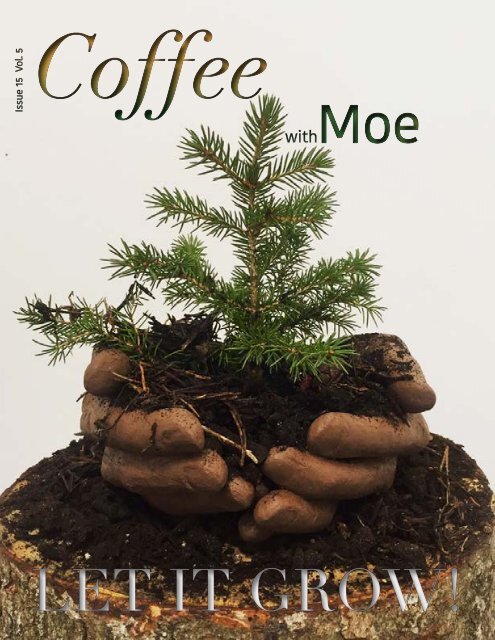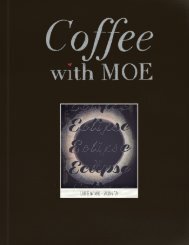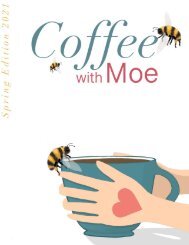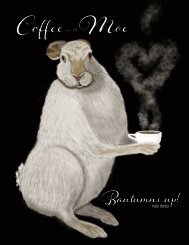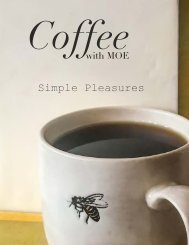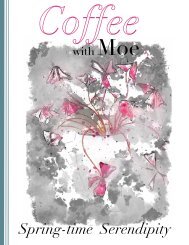Coffee with Moe - Let it Grow!
Grab a cuppa and take 5 while you sip, flip and let your mind grow full of ideas on gardening, sustainability, and more.
Grab a cuppa and take 5 while you sip, flip and let your mind grow full of ideas on gardening, sustainability, and more.
You also want an ePaper? Increase the reach of your titles
YUMPU automatically turns print PDFs into web optimized ePapers that Google loves.
Issue 15 Vol. 5<br />
<strong>Coffee</strong><br />
<strong>w<strong>it</strong>h</strong><strong>Moe</strong><br />
LET IT GROW!
<strong>Let</strong> <strong>it</strong> <strong>Grow</strong>!
07<br />
#ed<strong>it</strong>orial<br />
19<br />
#MrJack<br />
09<br />
#Lawn&Order<br />
07<br />
#BlossomBuddies<br />
13<br />
#MoonSavvy<br />
28<br />
#<strong>Let</strong><strong>it</strong>grow<br />
presents: <strong>Coffee</strong> <strong>w<strong>it</strong>h</strong> <strong>Moe</strong>, <strong>Let</strong> <strong>it</strong> grow!<br />
ISSUE 13: LET IT GROW!<br />
April 2020<br />
On The Cover:<br />
All My Relations by Peig Abbott<br />
For her artist statement please vis<strong>it</strong> Pg 6<br />
You can catch this piece and more in<br />
“Trans<strong>it</strong>ions” a group show exploring<br />
climate change @artsplacecanmore<br />
For dig<strong>it</strong>al Prints & Commission work, please<br />
Contact <strong>Moe</strong> at: monique@moecreative.com<br />
Webs<strong>it</strong>e: www.moecreative.com<br />
Blog: www.moecreative.com/blog<br />
Pinterest: www.pinterest.com/moecreative/<br />
IG: www.instagram.com/moe_creative<br />
<strong>Coffee</strong> <strong>w<strong>it</strong>h</strong> <strong>Moe</strong> Dig<strong>it</strong>al Magazine is<br />
published in association <strong>w<strong>it</strong>h</strong> <strong>Moe</strong> Creative<br />
Inc. based in Calgary, Alberta Canada<br />
Publishing made possible by <strong>Moe</strong> Creative, Yumpo & the<br />
Adobe Su<strong>it</strong>e of Products.<br />
* Art & photography by Monique DeNault<br />
Many thanks to Family, Friends & Inspiration:<br />
Gratefully & alphabetically:<br />
AB, AC, AG, AL, AR, BCV, BD, CF, CG, CR,<br />
CS, DD, DK, DL, DO, DR, EC, ED, EN, GD,<br />
GDC, HC, HM, IF, JD, JM, JR, JS, KH, KW,<br />
LB, LD, LK, LM, LOL, MB, MC, MH, MQ, MS,<br />
MY, ND, NH, NS, PA, PB, RC, RS, SB, SH,<br />
SK, SP, SMG, TN, TR, VH, YK.<br />
& all <strong>Moe</strong> Creative’s clientele & suppliers.<br />
All for whom this issue was created, <strong>w<strong>it</strong>h</strong><br />
heart & much grat<strong>it</strong>ude.<br />
© 2020 <strong>Moe</strong> Creative Inc. All rights reserved.
ALL MY RELATIONS<br />
Extend beyond the surface….<br />
Med<strong>it</strong>ate in that space where material<strong>it</strong>y and the fabric of existence are akin.<br />
Probe deeply….<br />
.…Remember.<br />
Three simple words. Combined, they have the power to change the world.<br />
“All My Relations” is a call to consciousness, and a bridge to universal connectiv<strong>it</strong>y.<br />
The phrase, “All My Relations”, has been the fabric of First Nations, Métis and Inu<strong>it</strong> beliefs and<br />
practices for centuries. Spoken in ceremony and prayer, <strong>it</strong> signifies deep awareness of the<br />
interrelationships between the physical, elemental and spir<strong>it</strong>ual realms. It honours the sacred<br />
relations of everything seen and unseen; trees, stone, beetles, the sun and moon, for example, are<br />
held in great reverence as ancestors and teachers central to existence. It is a phrase that embodies<br />
oneness. And <strong>it</strong>’s home is found in the heart.<br />
Common layers of analysis in this installation are dualistic tones such as nature vs. nurture, death/<br />
decay vs. life, human vs. environment, stasis vs. movement, etc. However, when probed deeper,<br />
awareness of the solid fragil<strong>it</strong>y of what appears as solid material is unsettling; the unfired clay body<br />
dries and begins to crack and decompose over the duration of the exhib<strong>it</strong>ion, as will the soil and<br />
sapling. The sculpture will depart the gallery in a different state from which <strong>it</strong> is first unveiled as a<br />
result of one essential ingredient: water.<br />
Do you recall that feeling when you took your last sip of water? Do you remember that sensation<br />
you had when the sun’s heat sat upon your face? What about that space of stillness in between the<br />
rhythm of trees dancing in the wind? What if, for one moment none of this existed? What then?<br />
All My Relations is a tribute to remembering the depth of our reliance on air, water, sunlight, the<br />
vibration of the Earth, and power of the universe for sustenance and perpetuation of life.<br />
I was asked the other day by an artist friend:<br />
“What one word or idea summarizes the idea of you?”<br />
“Sustainabil<strong>it</strong>y”, I blurted out.<br />
I’d never actually thought about summarizing myself before, but in the moment<br />
that I answered, I knew my subconscious blurt, revealed an underlying truth.<br />
Absolutely there are many ways I could become MORE sustainable.<br />
Couldn’t everyone?<br />
But I think sustainabil<strong>it</strong>y, in the way I think about <strong>it</strong>, is simply about doing my<br />
best every day, to show responsible stewardship towards all aspects of my life<br />
and surrounding environment.<br />
So <strong>w<strong>it</strong>h</strong> that blurt in mind, I bring you this latest issue of <strong>Coffee</strong> <strong>w<strong>it</strong>h</strong> <strong>Moe</strong>.<br />
I look forward to sharing a wealth of knowledge that I’ve gained from books,<br />
mother nature, contemplation, fellow gardeners, artists, philosophers and my<br />
own trial and error. Perhaps you’ll find some forgotten wisdom or some new<br />
treasures amongst <strong>it</strong>’s pages. At the very least, you’ll find an assortment of<br />
images and thoughts I’ve curated just for you.<br />
So grab a cuppa, s<strong>it</strong> back and take your mind off current affairs while you sip,<br />
flip and allow your thoughts to sustainably grow <strong>w<strong>it</strong>h</strong> the flow.<br />
It’s so great to have you here!<br />
<strong>Coffee</strong> is always better, shared together.<br />
Peig Abbott enjoys creating works for the viewer to dive deep into seen and unseen worlds, unveiling<br />
layers of meaning to stimulate authentic engagement. Captivated by the magic of how art can<br />
engage and repel two different individuals, Abbott’s work provides a mirror for the viewer to explore<br />
and reflect.<br />
XO<br />
<strong>Moe</strong>
DRAGON & DAMSEL FLIES<br />
Dragon and Damsel flies are two of the many<br />
beneficial fliers in your garden. Born in water,<br />
they are two of many reasons that <strong>it</strong>’s very<br />
important to do everything we can to promote<br />
healthy waterways and not use poison.<br />
These flying dragons are well known to eat<br />
hundreds of midges, mosqu<strong>it</strong>oes and horse<br />
flies every single day. That is a whole lot of<br />
summer relief in every single fly.<br />
Beyond the bliss of not getting b<strong>it</strong>, Dragons and<br />
Damsels help to reduce the diseases pest bugs<br />
carry, such as West Nile in humans and Heart<br />
Worm in our furry friends.<br />
Worried that these fast fliers can or will some<br />
how hurt you? Take a big sigh of relief. Not<br />
even the largest of these insects has been<br />
known to b<strong>it</strong>e, and that barb-y tail is not a<br />
stinger. (Phew!)
It may seem a l<strong>it</strong>tle strange for me to be<br />
talking about lawns. Especially since<br />
about 10 years ago, I removed every<br />
blade of grass from my yard.<br />
The reason I made such a radical<br />
change, began when researching<br />
how to resurrect the sad l<strong>it</strong>tle lawn I’d<br />
inher<strong>it</strong>ed <strong>w<strong>it</strong>h</strong> my house. I found that<br />
tens of millions of pounds in pesticides,<br />
hundreds of millions of gallons of gas<br />
and trillions of gallons of water were/<br />
are being used to maintain lawns per<br />
year? Impact from run off into our<br />
water systems and drinking water not<br />
to mention air born pollutants stacked<br />
up to a whole lot of environmental<br />
concerns. The idea of ripping the whole<br />
lawn out for a reboot seemed beyond<br />
a sustainable solution, <strong>it</strong> seemed<br />
downright sensible.<br />
Fast forward ten years and we still<br />
find plenty of lawns subjected to the<br />
“fast and easy” chemically supported<br />
method of care. The good news is,<br />
this doesn’t have to be the way <strong>it</strong> is.<br />
W<strong>it</strong>h a growing global focus on the<br />
environment, companies are starting to<br />
see a monetary benef<strong>it</strong> to bringing back<br />
more eco-friendly forms of lawn care.<br />
You see <strong>it</strong>’s not that our lawns need<br />
chemicals, <strong>it</strong>’s just that we’ve been<br />
marketed that this is the only way they<br />
will thrive.<br />
(If you can’t live <strong>w<strong>it</strong>h</strong>out your lawn,<br />
this part is for you!)<br />
When lawns first became a thing,<br />
lawn seed packages contained more<br />
than just lawn seed? It’s true. Clover<br />
(a n<strong>it</strong>rogen fixer), tiny flowers to feed<br />
the bees and other beneficial plants<br />
to reduce soil compaction used to<br />
naturally be part of each lawns ecosystem.<br />
These add<strong>it</strong>ional plants helped<br />
keep lawns and soil healthier <strong>w<strong>it</strong>h</strong> a<br />
side benef<strong>it</strong> of assisting bio-divers<strong>it</strong>y by<br />
creating a lush oasis of food for birds,<br />
bees and butterflies while providing a<br />
healthy playground for our l<strong>it</strong>tle ones<br />
(children and pets alike)<br />
Those days aren’t beyond us.<br />
Companies are now seeing the value<br />
of selling alternative lawn options<br />
that require less water, less mowing<br />
and no pesticides.<br />
Things, <strong>it</strong> seems, are coming full circle.<br />
Many seed companies are now offering<br />
eco-friendly seed mixes to combat<br />
drought cond<strong>it</strong>ions, soil recovery and<br />
are as easy to use as overseeding the<br />
lawn you already have in place.<br />
It’s a win / win for lawn lovers and<br />
nature alike. It’s time we play together<br />
again.<br />
Lawn & Order
I found this idealic scene just outside of<br />
Carcassonne, a Unesco World Her<strong>it</strong>age<br />
s<strong>it</strong>e, in the south of France.<br />
The village was called Pennautier and <strong>it</strong><br />
had <strong>it</strong>’s very own chateau surrounded by<br />
well manicured trees and a lush drought<br />
resistant lawn.<br />
Hours earlier, this front lawn was the<br />
scene of a wildly chaotic Easter Egg hunt<br />
for local children. Yet, after hours of<br />
chaos and commotion, the sprawling lawn<br />
revealed nothing, but <strong>it</strong>’s naturally rugged<br />
beauty. (the l<strong>it</strong>tle wh<strong>it</strong>e and yellow dots are<br />
hundreds of beneficial flowers)<br />
A beautiful Easter memory filled <strong>w<strong>it</strong>h</strong><br />
chocolate, laughter and a reminder that<br />
nature is so much more than meets the eye.<br />
- <strong>Moe</strong>
Every phase of<br />
your life teaches<br />
you how to grow,<br />
how to heal, and<br />
how to deal.<br />
- Anish Kapoor
Moon Savvy<br />
I wasn’t always a green thumb. In fact, I<br />
sometimes wonder if I actually am. Maybe<br />
<strong>it</strong>’s that I put my trust in nature to do the<br />
dirty work for me. In fact...<br />
I know that’s what I do. Thanks Mother<br />
Nature and Grandmother Moon, you really<br />
know your stuff!<br />
Have you ever wondered why certain,<br />
usually seasoned, gardeners plant<br />
earlier some years and later others? At<br />
first, <strong>it</strong> may seem completely random,<br />
but whenever they get to <strong>it</strong>, their<br />
gardens seem to flourish <strong>w<strong>it</strong>h</strong> ease and<br />
abundance.<br />
Is this just the result of a green thumb? Or<br />
is there something else at work?<br />
I think <strong>it</strong>’s the latter. They’re likely tuned<br />
into the natural rhythms of the earth<br />
and how they relate to the grav<strong>it</strong>ational<br />
influence of the moon <strong>w<strong>it</strong>h</strong>in their gardens.<br />
It may sound a b<strong>it</strong> whacky at first, but <strong>it</strong>’s a<br />
method that’s been used qu<strong>it</strong>e accurately<br />
by farmers for centuries, to the benef<strong>it</strong> of<br />
many bumper crops.<br />
They call this method of gardening:<br />
Gardening by the Moon and <strong>it</strong> saves<br />
wasted time weeding when weeds are<br />
firmly rooted, sewing seeds when the<br />
ground is not optimal for growth and<br />
planting seedlings out, before killing frosts<br />
have subsided.<br />
Is <strong>it</strong> possible for you to become a Moon<br />
Savvy gardener too?<br />
Absolutely.<br />
Here are 5 easy ways that gardening by<br />
the moon can transform your gardening<br />
woes into results that will impress even<br />
the best of gardeners.<br />
Be aware, that these general rules take<br />
into account seeds, root systems and<br />
plant types. So they work regardless, if<br />
you are planting indoors or out.<br />
1.<br />
Plant Annuals and vegetables that bear<br />
fru<strong>it</strong> above ground from the day the moon<br />
is new to the day the moon is full.<br />
2.<br />
Plant flowering bulbs, root vegetables,<br />
biennial and perennial flowers from the<br />
day after the moon is full to the day before<br />
<strong>it</strong>’s a new moon again.<br />
3.<br />
The best time to weed, prune, mow and<br />
thin plantings is after the full moon (I<br />
usually wa<strong>it</strong> a couple of days) until the<br />
time of the new moon.<br />
4.<br />
During drought cond<strong>it</strong>ions, <strong>it</strong> is considered<br />
best to plant just before the moon is full.
Moon Savvy cont’d<br />
5. Find plenty more planting by the moon<br />
information in the Farmers Almanac.<br />
There are Canadian and American<br />
versions chalk full of great articles and<br />
the promise of bountiful results regardless<br />
of where you live. Support the Farmers<br />
Almanac by purchasing their on-line or<br />
in print Almanac for about the price of a<br />
large coffee. The Almanac is filled <strong>w<strong>it</strong>h</strong> fun<br />
facts, interesting tips regarding Gardening<br />
by the moon, tide schedules, weather and<br />
more gardening plus a slew of other useful<br />
information. Don’t tell them I said so, but I<br />
think the almanac is an absolute steal!<br />
Get yours here: www.almanac.com<br />
Arm yourself <strong>w<strong>it</strong>h</strong> gardening know-how<br />
that will serve to lessen your time toiling in<br />
the soil and free up more time to enjoy the<br />
fru<strong>it</strong>s of your garden.<br />
Who knows, maybe the joy of less<br />
weeding is actually the reason why people<br />
are seen dancing under the light of the<br />
moon. Happy growing.
Mr Jack<br />
Many moons ago, I had a very hungry Jack Rabb<strong>it</strong> who thought<br />
my yard was the local supermarket. Day after day I watched him<br />
eat and eat all of the ripening poppyseed heads until not a single<br />
seed head remained for re-seeding the following spring.<br />
While I understood that this fuzzy fellow needed to eat, and<br />
that his ancestors probably grazed freely where my house now<br />
stood, I still needed a plan. A plan that would make us both<br />
happy. So, the following spring, I not only bought more poppy<br />
seeds, but I also bought a bunch of delicious looking lettuce for<br />
Mr Jack.<br />
Off I went at planting time, making sure that patches of lettuce<br />
were obscuring my poppy patch from view. As the spring days<br />
grew longer, the lettuce grew beautifully lush. I was sure my<br />
poppies were saved until that fateful morning when I opened my<br />
bathroom window to see, Mr Jack, pol<strong>it</strong>ely poised on a lovely<br />
cool pillow of lettuce. In his hands and fattening cheek, a<br />
decidedly more delicious poppy seed head.<br />
Mr Jack taught me a few very cr<strong>it</strong>ical lesson that summer:<br />
• Be sure to plant him a sacraficial menu that is more appealing<br />
than what I want to save.<br />
• Create protective and mutually beneficial barriers<br />
• or simply plant a more abundant swath of my favour<strong>it</strong>es.<br />
These 3 measures have helped my relationship <strong>w<strong>it</strong>h</strong> Mr Jack<br />
tremendously.<br />
How did I manage to appease Mr Jack? I chose to plant a delicious<br />
thicket of wild roses over and around his entrance to my<br />
garden. While he loves the rose-hips <strong>w<strong>it</strong>h</strong> as much vigour as the<br />
poppies, he’s actually giving my rose bushes a handy l<strong>it</strong>tle<br />
pruning, while saving me from the prickly potential of having to<br />
weed new seedlings.<br />
Now that’s what I call living in harmony!<br />
Rabb<strong>it</strong> Resistant Plants<br />
• Lantana<br />
• Pot Marigold<br />
• Snapdragons<br />
• Wax Begonias<br />
• Geraniums<br />
• Vinca<br />
• Salvia<br />
• Sunflowers<br />
• Milk Weed<br />
• Globe Thistle<br />
• Sweet Alyssum<br />
• Catmint<br />
• Wormwood<br />
• Shirley Poppies<br />
• Strawflower<br />
• Floss Flower<br />
• Peppers<br />
• Tomatoes<br />
• Artichokes<br />
• Asperagus<br />
• Onions<br />
• Squash<br />
• Potatoes<br />
• Cucumber<br />
• Corn<br />
• Garlic<br />
• Leeks<br />
• Rhubarb<br />
• Gooseberries<br />
• Many herbs...
Mr Jack cont’d<br />
To be clear, most cr<strong>it</strong>ters can be deterred but not completely<br />
eliminated. After all, our gardens are sometimes the only nature<br />
that animals can access. They’re not trying to tick us off, they’re<br />
actually just trying to survive <strong>w<strong>it</strong>h</strong>out central heating,<br />
grocery stores or the natural environment that was around<br />
before the c<strong>it</strong>y, town or farm you’re part of eliminated their<br />
natural food sources. As stewards of our land, <strong>it</strong>’s really<br />
important that we understand that while we might only see the<br />
destruction they cause, there is nothing on this planet that is<br />
<strong>w<strong>it</strong>h</strong>out <strong>it</strong>’s value. Our eco-sytem is all interconnected.<br />
The best thing to do is to cultivate a climate that is less<br />
hosp<strong>it</strong>able to your gardening foes. Allow them to migrate to<br />
richer pastures and here are some of the ways you can do just<br />
that:<br />
Empty standing water, plant scented herbs and plants like<br />
lavender or geranium while wearing light toned clothes to deter<br />
mosqu<strong>it</strong>oes<br />
Sprinkle diatomaceous earth around affected plants, keep beer<br />
traps and reduce soppy wet areas to deter slugs<br />
Rake up debris around your garden and keep the ground<br />
beneath your bird feeders cleaned up to deter mice from finding<br />
food and lodging on your property.<br />
Plant herbs or follow companion gardening practices to deter<br />
many bugs including aphids from your precious plants.<br />
To deter squirrels, add baffles to your big bird feeders and metal<br />
collar your trees.<br />
For deer, ask your local zoo for predator manure to frighten deer<br />
away, or plant a deterring perimeter so they simply move on.<br />
Deer Resistant Plants<br />
• Fox Glove<br />
• Ferns<br />
• Wormwoods<br />
• Larkspur<br />
• Broom<br />
• Asters<br />
• Snapdragons<br />
• Baptisia<br />
• Buddleia<br />
• Allium (Onion<br />
family of plants)<br />
• Lavender<br />
• Borage<br />
• Pot Marigolds<br />
• Bergamots<br />
• Fescues<br />
• Rugosa Roses<br />
• Salvia<br />
• Vibernum<br />
• Catnips<br />
• Asperagus<br />
• Rhubarb<br />
• Eggplant<br />
• Artichoke<br />
• Fig<br />
• Carrots<br />
• Fennel<br />
• Echinacea<br />
• Forget-me-not<br />
• Many herbs...
Blossom Buddies<br />
I believe life is so much better <strong>w<strong>it</strong>h</strong> friends and I’m not<br />
the only one. Plants feel that way too. I noticed the<br />
astonishing difference in the growth of plants when<br />
they were <strong>w<strong>it</strong>h</strong> friends vs alone qu<strong>it</strong>e a while ago and<br />
decided to look into <strong>it</strong>.<br />
Thats when I found out about companion plants.<br />
Companions are plant besties that, like any good<br />
friend, helps their buddies thrive. The first way is<br />
by living in close proxim<strong>it</strong>y. Sometimes this creates<br />
weather shelter, sometimes they increase useful<br />
nutrients like n<strong>it</strong>rogen to the soil, sometimes they repel<br />
harmful bugs. However they contribute, the bottom line<br />
is, that your desired veggies, fru<strong>it</strong>s and flowers thrive<br />
easier <strong>w<strong>it</strong>h</strong> a l<strong>it</strong>tle help from their friends<br />
How can you go about planting companions? Here are<br />
some helpful hints:<br />
THE UPSIDE OF COMPANION PLANTING<br />
1<br />
Companion planting doesn’t have to cost a fortune.<br />
Many plants can be easily grown by seed for a fraction<br />
of what <strong>it</strong> would cost to buy seedlings.<br />
2.<br />
Borage and other flowers are not just pretty faces.<br />
They are a great add<strong>it</strong>ion to the garden, because<br />
beyond their beauty, they attract pollinators which can<br />
increase your yields.<br />
3.<br />
Companion plants can inv<strong>it</strong>e more than pollinators to<br />
your yard. Some attract beneficial bugs like ladybugs<br />
and spiders who work along side companions to dine<br />
on harmful bugs that are persistent enough to make <strong>it</strong><br />
through your companion’s defences.
cont’d<br />
THE DOWN SIDE OF COMPANION PLANTING<br />
1.<br />
Some plants, like people, just don’t get along. It<br />
happens. Be sure when looking up companions, you<br />
also look up what plants don’t play well together and<br />
why.<br />
2.<br />
Companion planting helps, <strong>it</strong>’s not a miracle worker.<br />
Enlist the help of simple fencing or netting, plant<br />
nutr<strong>it</strong>ion and perhaps an organic soap spray along the<br />
way.<br />
3.<br />
Companion planting may seem confusing at first and<br />
sometimes there is even conflicting information on the<br />
internet. The best thing you can do, is don’t over think<br />
<strong>it</strong>. Do what you can, experiment for yourself and keep<br />
a log of what works and what doesn’t so that you grow<br />
into a confident guru of your own l<strong>it</strong>tle patch.<br />
An extra tip or two:<br />
Plant specific webs<strong>it</strong>es such as:<br />
www.gardeningknowhow.com can become great<br />
resources to help you start your exploration of the right<br />
companions for your yard and planting zone.<br />
If you are more of a book worm, a great companion<br />
planting book is called:<br />
Carrots Love Tomatoes, by Louise Riott<br />
or again, the Farmers Almanac (no I am not sponsered<br />
by them, I’ve just gleaned loads of useful knowledge<br />
from the pages of their publications)<br />
ps. Tomatoes & Basil are well known companions.<br />
Not only on the table, but in the garden too.
We all know these are hard times.<br />
No one needs me to confirm that for<br />
them. We’re entering a brave new world<br />
that is a mix of emotional strife and joy<br />
<strong>w<strong>it</strong>h</strong> a pinch of (sometimes scary) new<br />
potential. It’s a strange brew. Not a blend<br />
that many of us would take on willingly.<br />
But here we are.<br />
I trust that you enjoyed this ed<strong>it</strong>ion of<br />
<strong>Coffee</strong> <strong>w<strong>it</strong>h</strong> <strong>Moe</strong>. That <strong>it</strong> might contribute<br />
in some way to the growth of a good,<br />
wholesome and rewarding life around you<br />
and <strong>w<strong>it</strong>h</strong>in you. Every moment we spend<br />
doing med<strong>it</strong>ative tasks like moments<br />
enjoyed over warm beverages, reading,<br />
gardening, playing or listening to music<br />
etc. <strong>Let</strong>’s us grow in unexpected ways<br />
and that is what I want for you.<br />
May this movement into spring allow<br />
you to plant new ideas and beauty in<br />
your own unique ways. Thanks so much<br />
for joining me for this cuppa and I look<br />
forward to connecting <strong>w<strong>it</strong>h</strong> you again<br />
soon.<br />
XO<br />
<strong>Moe</strong>
Catch you<br />
this October<br />
for the next<br />
<strong>Coffee</strong> <strong>w<strong>it</strong>h</strong> <strong>Moe</strong>!


